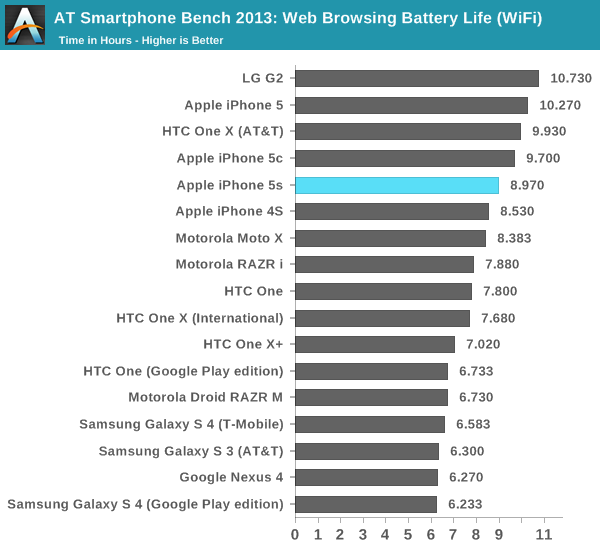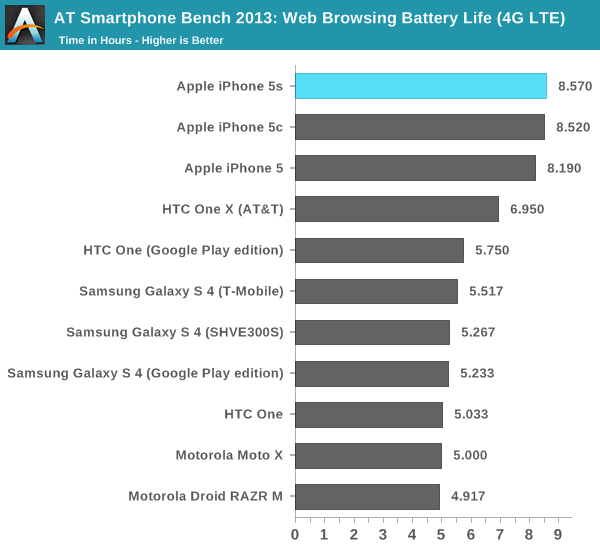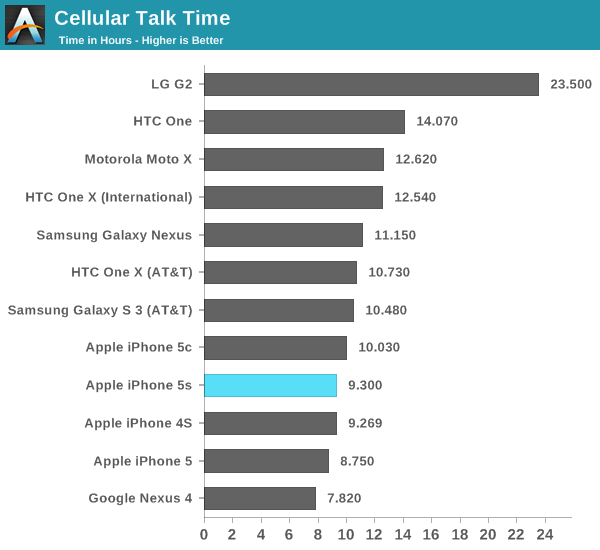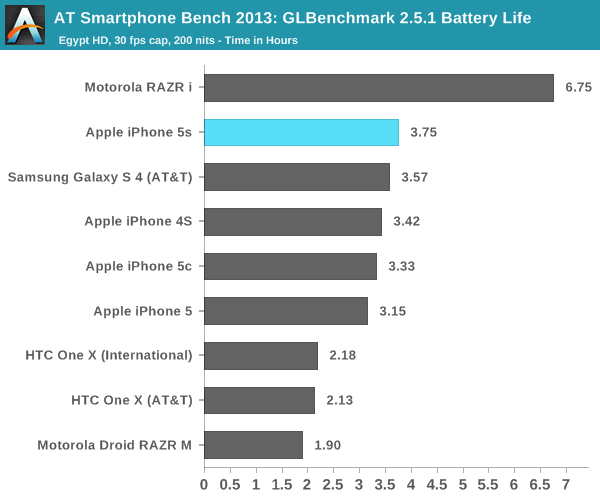The iPhone 5s Review
by Anand Lal Shimpi on September 17, 2013 9:01 PM EST- Posted in
- Smartphones
- Apple
- Mobile
- iPhone
- iPhone 5S
Battery Life
Brian did some excellent sleuthing and came across battery capacities for both the iPhone 5s and 5c in Apple’s FCC disclosures. The iPhone 5 had a 3.8V 5.45Wh battery, while the 5s boosts total capacity to 5.96Wh (an increase of 9.35%). The move to a 28nm process doesn’t come with all of the benefits of a full node shrink, and it’s likely not enough to completely offset the higher potential power draw of a much beefier SoC. Apple claims the same or better battery life on the 5s compared to the iPhone 5, in practice the answer is a bit more complicated.
Unlike previous designs, we’ve never had a half node shrink for an s-SKU. Both the iPhone 3GS and iPhone 4S stayed on the same process node as their predecessor and drove up performance. In the case of the 3GS, the performance gains outweighed their power cost, while in the case of the iPhone 4S we generally saw a regression.
The iPhone 5s improves power consumption by going to 28nm, but turns that savings into increased performance. The SoC also delivers a wider dynamic range of performance than we’ve ever seen from an Apple device. There’s as much CPU power here as the first 11-inch MacBook Air, and more GPU power than an iPad 4.
To find out the balance of power savings vs. additional performance I turned to our current battery life test suite, which we first introduced with the iPhone 5 review last year.
We'll start with our WiFi battery life test. As always, we regularly load web pages at a fixed interval until the battery dies (all displays are calibrated to 200 nits).

The iPhone 5s regresses a bit compared to the 5 in this test (~12% reduction despite the larger battery). We're loading web pages very aggressively here, likely keeping the A7 cores running at their most power hungry state. Even the 5c sees a bit of a regression compared to the 5, which makes me wonder if we're seeing some of the effects of an early iOS 7 release here.
The story on LTE is a bit different. Here we see a slight improvement in battery life compared to the iPhone 5, although the larger battery of the 5s doesn't seem to give it anything other than parity with the 5c:

Our cellular talk time test is almost entirely display and SoC independent, turning it mostly into a battery capacity test:

You can see the close grouping of the smaller iPhones at the bottom of the chart. There's a definite improvement in call time compared to the iPhone 5. We're finally up above iPhone 4S levels there.

Our Egypt HD based 3D battery life test gives us the first indication that Rogue, at least running fairly light code, can be more power efficient than the outgoing 5XT. Obviously the G6430 implemented here can run at fairly high performance levels, so I'm fully expecting peak power consumption to be worse but for more normal workloads there's no regression at all - a very good sign.










464 Comments
View All Comments
akdj - Thursday, September 19, 2013 - link
I'm with ya on the note. I bought the original GNote and the contract can't end quick enough. It's a dog! Slow as molasses and my wife and each own one as our 'business' phones. Made sense, our clients can sign with the stylus their credit card authorization. We use the Square system for CCs and we won't be buying the Notes again. I think you're right. TouchWiz is a killercoolhardware - Tuesday, September 17, 2013 - link
Very true, however, it is my understandingthat sometimes Apple can use their volume to (A) get things a bit before everyone else (like when Apple gets Intel CPUs before others) or (B) get something special added/tweaked/improved on an existing component (batteries, displays, materials).Sorry to not have more definitive references/examples for (A) & (B) but here's a recent illustration:
http://www.macrumors.com/2013/07/26/intel-to-suppl...
How much this really happens I do not know, but I imagine suppliers want to keep Apple happy :-)
akdj - Tuesday, October 8, 2013 - link
They sold more iOS devices last year (200,000,000) than vehicles sold in the world. They're still the world's number one selling 'phone'. Samsung makes a dozen...maybe two? Their flagships tend to sell well (wasn't the S3 close to 30mil @ some point?)---but no where near the iPhone specific sales figures....when you're dealing in that quantity--ya betcha....you'll have access, pricing and typically 'pick of the litter'melgross - Wednesday, September 18, 2013 - link
Display density is now nothing more than a marketing tool. It no longer serves any purpose. Displays with ppi's of over 350 don't give us any apparent extra sharpness, as we can't see it. The Galaxy S4 has a much higher Rez display, but it still uses PenTile, so that extra Rez is only allowing the screen to look as good as a lower Rez display. I'm wondering what Apple will do with the iPad Retina. If they do what they've been doing, then the display will have four times the number of pixels, and will be one of, if not the highest ppi displays on the market. They do that to make it easy for developers, but it's obviously unnecessary. No one has ever been able to see the pixels on my 326 ppi iphone display. in fact, no one has ever seen the pixels on my 266 ppi ipad Retina display. Hopefully we'll find out in a month.melgross - Wednesday, September 18, 2013 - link
Oops! I meant what will they be doing with the iPad Mini Retina display of course.ESC2000 - Saturday, September 21, 2013 - link
There isn't one definitive cutoff above which extra pixels are useless since people hold their phones different distances from their faces and people have varying eyesight. 'Retina' is pure marketing - first apple used it to emphasize how great their high rez (for the time) screens were (and they did look a lot better than 15" 1366x768 screens) and now they're using it to disguise the fact that this is the same low rez (for the time) screen that they've had on the iPhone 5 for a year.I don't even have good eyesight but even I can see that the LG G2 screen (441 PPI) is better than my nexus 7 2013 screen (323 PPI) which is better than the iPad 3 screen (264 PPI - I don't have the 4 for comparison) which is miles better than the iPad mini screen (163 PPI). Personally I'd slot the iPhone 5 after the nexus 7 2013 on that list even though the PPI are about the same. Obviously other factors, often subjective, affect our preferences. I find most apple screens washed out but many people feel they are the only true color reproductions.
Regardless the random arbitrary cutoffs beyond which extra PPI supposedly makes no difference is a copout.
tuxRoller - Tuesday, September 17, 2013 - link
Great review. I wish we could see this for the other architectures/socs.If want to see the code for the benchmarks (and you should) there are plenty of oss suites you can choose from. You could use linaro's if you want, but for the stream benchmark you could grab http://www.cs.virginia.edu/stream/FTP/Code/ and compile it on xcode.
abrowne1993 - Tuesday, September 17, 2013 - link
Not a single Lumia in the camera comparison? Why? The people who are really concerned about their smartphone's camera performance will put up with the WP8 platform's downsides.A5 - Tuesday, September 17, 2013 - link
I would guess Anand doesn't have a 1020 handy to compare with. Probably have to wait for Brian on that one.Anand Lal Shimpi - Wednesday, September 18, 2013 - link
This. I only compared to what I had on hand.